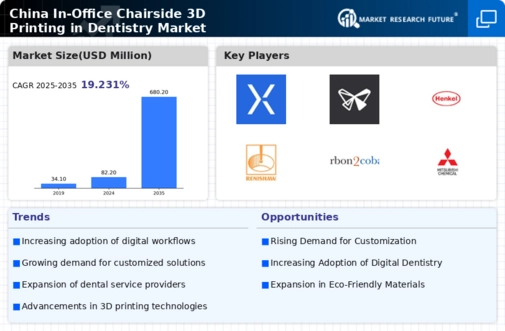Supportive Government Policies
Supportive government policies are playing a crucial role in shaping the in office-chairside-3d-printing-in-dentistry market in China. The government has been actively promoting the adoption of advanced manufacturing technologies, including 3D printing, within the healthcare sector. Initiatives aimed at enhancing dental care accessibility and quality are encouraging dental practices to invest in innovative technologies. Furthermore, funding programs and incentives for research and development in dental technologies are likely to stimulate market growth. As these policies continue to evolve, they may lead to an increase in the number of dental practices adopting in office-chairside-3d-printing solutions, thereby expanding the market landscape.
Rising Demand for Customization
The in office-chairside-3d-printing-in-dentistry market in China is experiencing a notable increase in demand for customized dental solutions. Patients are increasingly seeking personalized treatments, which has led to a surge in the adoption of 3D printing technologies. This trend is supported by the growing awareness of the benefits of tailored dental products, such as crowns, bridges, and aligners. According to recent data, the market for customized dental solutions is projected to grow at a CAGR of approximately 15% over the next five years. This rising demand for customization is driving dental practices to invest in office-chairside-3d-printing technologies, enabling them to provide faster and more efficient services to their patients.
Cost Efficiency and Time Savings
Cost efficiency is a critical driver for the in office-chairside-3d-printing-in-dentistry market in China. Traditional dental manufacturing processes often involve significant time and financial investments. In contrast, in-office 3D printing allows dental practitioners to produce dental appliances on-site, reducing the need for outsourcing and minimizing production costs. This shift not only lowers expenses but also shortens turnaround times for patients, enhancing overall satisfaction. Reports indicate that practices utilizing in office-chairside-3d-printing can reduce production costs by up to 30%, making it an attractive option for dental professionals looking to optimize their operations while maintaining high-quality standards.
Integration of Digital Technologies
The integration of digital technologies into dental practices is significantly influencing the in office-chairside-3d-printing-in-dentistry market in China. The adoption of CAD/CAM systems and digital scanning tools is facilitating the seamless transition to 3D printing. These technologies enable precise measurements and designs, which are essential for producing high-quality dental products. As more dental clinics embrace digital workflows, the demand for in office-chairside-3d-printing solutions is expected to rise. It is estimated that by 2026, over 60% of dental practices in China will have integrated digital technologies, further propelling the growth of the in office-chairside-3d-printing market.
Increasing Focus on Patient-Centric Care
The shift towards patient-centric care is becoming a prominent driver in the in office-chairside-3d-printing-in-dentistry market in China. Dental professionals are increasingly prioritizing patient needs and preferences, leading to a demand for more accessible and efficient treatment options. In-office 3D printing allows for immediate adjustments and rapid prototyping, which enhances the patient experience. This focus on patient satisfaction is likely to encourage more dental practices to adopt in office-chairside-3d-printing technologies. As a result, the market is expected to witness a growth rate of around 12% annually as practices strive to meet the evolving expectations of their patients.






















Leave a Comment